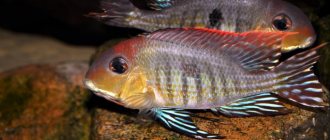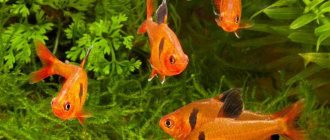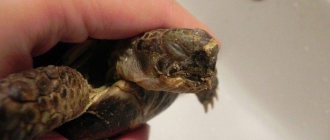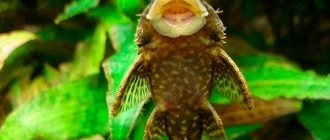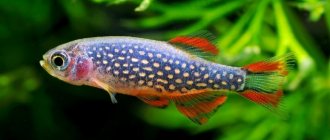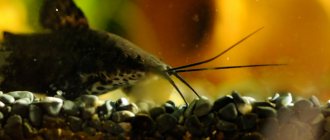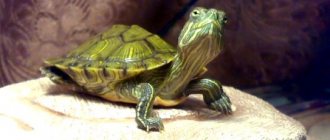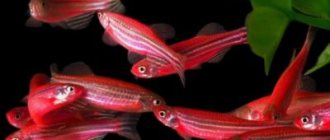Description
The red-eared turtle is a medium-sized reptile, which, depending on its gender, has a length of the upper part of the shell (carapace) from eighteen to thirty centimeters. The body of the reptile is hidden in a reliable and durable shell, which consists of bone covered with horny plates. The thin long tail, head and limbs remain outside and, in case of danger, are retracted under the armored shields.
The head of the individual is covered with a hard horny covering, which successfully compensates for its lack of teeth, forming sharp edges on the edge of the jaws. The red-eared slider spends most of its life in the water, having webbed swimmers on its hind legs and flattened forelimbs.
The red-eared turtle has undeveloped vocal cords and therefore can snort in excitement and hiss in defense. The individual has a fairly developed sense of smell and vision, and its eyes, which are located on the sides, are reliably protected by movable eyelids. Despite the underdeveloped hearing, the reptiles navigate well by it and hide in the water at any rustle.
In the area of the reptile's ears there are spots or stripes of red color, and in some of its subspecies they can be yellow. Nature has generously endowed the Red-eared turtle with an unusual and amazing shell pattern, the continuation of which can be seen on its limbs and head in the form of green and white wavy spots and stripes. The oval lower part of the shell (plastron) of the individual is dark in color with yellow lines. Young carapace has a bright green color, which becomes yellow-brown or olive with age. The life expectancy of the reptile is thirty years.
Interesting facts about red-eared turtles
• Turtles have lived on earth for almost 200 million years, they appeared long before birds, crocodiles, mammals and even lizards; • In Russia, freshwater turtles with a characteristic red spot on the head are called red-eared, and in Germany – red-cheeked; • Red-eared turtles, like most representatives of this species, are long-lived; in captivity they can live 30 years; • Red-eared turtles have a well-developed sense of smell, vision and touch, and their shell contains a large number of nerve endings.
You can buy red-eared turtles in a specialized nursery. The price of red-eared slider turtles can be found on the bulletin board.
Features of character and lifestyle
Photo: Large red-eared turtle
Red-eared turtles live from 20 to 30 years, but can live more than 40 years. The quality of their habitat has a strong influence on life expectancy and well-being. Turtles spend almost all their time in the water, but since they are cold-blooded reptiles, they leave the water to sunbathe in order to regulate their body temperature. They absorb heat more efficiently when their limbs are extended outward.
Red whales do not hibernate, but plunge into a kind of suspended animation. When turtles become less active, they sometimes come to the surface for food or air. In the wild, turtles spend the winter at the bottom of ponds or shallow lakes. They generally become inactive in October when temperatures drop below 10°C.
During this time, turtles enter a state of stupor, during which they do not eat or defecate, remain almost motionless, and their breathing rate drops. Individuals are most often found underwater, but have also been found under rocks, in hollow stumps and sloping banks. In warmer climates, they can become active in winter and come to the surface to swim. When the temperature begins to drop, they quickly return to a state of stupor.
On a note! Red-eared turtles are caught for food from early March to late April.
During brumation, the species can survive anaerobically (without air) for several weeks. The turtles' metabolic rate drops sharply during this time, and heart rate and cardiac output are reduced by 80% to minimize energy requirements.
Reproduction
In the wild, sexual maturity in a reptile occurs when the red-eared slider is at least 8 years old. Reproduction of red-eared turtles at home is possible noticeably earlier, since with proper maintenance they mature much faster. The male is ready to mate at 4 years old, and the female at 6 years old. Mating of red-eared turtles occurs mainly between February and May. Few people manage to observe how reptiles reproduce at home.
Breeding red-eared turtles in captivity is only accessible to a very experienced owner who has the necessary equipment. If you have a question about how to find out the age and how to distinguish females from males, you should contact your veterinarian. He will be able to both find out the sex of the red-eared turtle and determine its age.
The behavior of red-eared turtles during the mating season is an interesting spectacle due to the courtship of males with females. The male is located directly in front of the swimming female, he himself also swims, but with his back forward and at this time tickles the partner’s chin with long claws.
Turtles in nature lay their eggs on the shore, having first dug a nest in the ground. Female turtles lay up to 10 eggs. The incubation period lasts 150 days. An interesting feature is the effect of the temperature at which red-eared turtle eggs are incubated on the sex of the turtles. If it is less than 27 degrees, then males will appear. If it is 30 degrees and above - females. All species of red-eared turtles lack parental instincts, and after hatching the young are left to their own devices.
If the turtle has eaten well, grown and become large, when maturity approaches, males and females mate easily. However, it will not be possible to wait for the reptile to lay eggs, and once laid, they are successfully incubated, and turtles emerge from the eggs.
Appearance and features
Photo: Animal red-eared turtle
The length of the shell of this type of turtle can reach 40 cm, but the average length ranges from 12.5 to 28 cm. Females are usually larger than males. Their shell is divided into two sections: the upper or dorsal carapace (carapace) + the lower, abdominal (plastron).
The upper shell consists of:
- vertebral shields, which form the central elevated part;
- pleural shields located around the vertebral shields;
- edge shields.
The scutes are bony keratin elements. The carapace is oval and flattened (especially in men). The color of the shell changes depending on the age of the turtle. The carapace usually has a dark green background with light or dark markings. In young or newly hatched specimens, this is the color of the green foliage, which gradually darkens in mature specimens. Until it turns dark green and then changes shade between brown and olive green.
The plastron is always light yellow with dark, paired, irregular markings in the center of the shields. The head, legs and tail are green with thin, irregularly shaped yellow lines. The entire shell is covered with stripes and markings that help in camouflage.
Interesting fact! The animal is a poikilotherm, that is, it cannot independently regulate its body temperature and is completely dependent on the temperature of the environment. For this reason, they need to sunbathe frequently to stay warm and maintain their body temperature.
Turtles have a complete skeletal system with partially webbed feet that help them swim. The red stripe on each side of the head distinguished the red-eared slider from other species and became part of the name, as the stripe is located behind the eyes where their (outer) ears would be.
These stripes may lose their color over time. Some individuals may have a small marking of the same color on the top of the head. In addition, they do not have a visible outer ear or external auditory canal. Instead, there is a middle ear, completely covered with a cartilaginous tympanic disc.
If there are several animals
In one aquarium you can only keep individuals of similar size. His safety depends on the size of the neighbor. If young animals are placed with an adult reptile, it can easily inflict serious injuries on it, deliberately freeing its territory. When several pets live in an aquarium, fights can begin between them due to the formation of a hierarchy. If there is not enough space, such skirmishes often lead to the fact that weaker individuals are left without paws and tails, and sometimes die.
In order to reduce the aggressiveness of your pets, you need to feed them individually and outside the aquarium. This way the animals will not build a hierarchy and organize massacres. Shelters will also help. The behavior of reptiles is the same as in the wild, which is why all the difficulties arise due to the fact that they do not have sufficient areas. To eliminate this unpleasant phenomenon, you should still keep your pets alone. This will make it easier for both them and the owner. The absence of a neighbor does not affect the animal's condition, and it does not feel lonely.
Watch a video of interesting facts about turtles.
Where does the red-eared turtle live?
Photo: Little red-eared turtle
Habitats are in the Mississippi River and Gulf of Mexico, as well as in the warm climate of the southeastern United States. Their home territories range from southeastern Colorado to Virginia and Florida. In the wild, red-eared turtles inhabit areas with sources of calm, warm water: ponds, lakes, swamps, streams and slow-moving rivers.
They live where they can easily get out of the water, climb onto rocks or tree trunks to warm themselves in the sun. They often sunbathe in a group or even on each other. These turtles in the wild always stay close to water unless they are searching for new habitat or laying eggs.
Due to their popularity as pets, red whales have been released or escaped into the wild in many parts of the world. Wild populations are now found in Australia, Europe, Great Britain, South Africa, the Caribbean, Israel, Bahrain, the Mariana Islands, Guam, and Southeast and Far East Asia.
An invasive species has a negative impact on the ecosystems it occupies because it has certain advantages over native inhabitants, such as a lower age at maturity and higher fertility rates. They transmit diseases and displace other turtle species with which they compete for food and breeding space.
Habitats
The red-eared turtle lives in the wild in the United States - from the southern borders of Virginia to Mexico, where they are also common, as well as in Venezuela and Colombia. The introduced red-eared turtles have acclimatized well in Spain, Great Britain and Israel. There are also populations in South Africa and Australia. On the Green Continent, the species is considered harmful, as it disrupts the natural balance of flora and fauna. Reptiles in Australia are actively displacing endemic reptiles, since they eat the same food and reproduce easily, and therefore they are being fought against.
In Russia, adult red-eared whales have been seen many times in the reservoirs of the Krasnodar Territory and Rostov-on-Don. The local aquatic environment suited her. However, red-eared turtles, whose reproduction is active, have not yet formed a wild population in Russia, since their young and eggs have not been found. We can talk about a formed population only when animals reproduce.
Red-eared fish live in shallow bodies of water - lakes and ponds, the banks of which are not very swampy. The animal's lifestyle is inactive. Reptiles love to sit on driftwood, basking in the sun, and when hungry, they swim in the water in search of food.
Red-eared slider: care
Red-eared turtles can be kept in groups or alone. But in any case, it is necessary to keep in mind that for one individual you need an aquaterrarium with a volume of at least 110-130 liters .
You should not assemble a group of only males. Otherwise, there will be constant battles for territory. Also, all individuals must be the same size and age. Caring for an animal at home is generally not accompanied by any serious difficulties. However, for the normal development of a turtle you need to know some important points.
Where does a small reptile spend the winter and can it hibernate in an aquarium?
When the correct temperature is maintained, the red-eared turtle does not hibernate. But there are exceptions. They carefully prepare for hibernation.
The temperature at the hibernation site is maintained at +1/+6 degrees.
Two months before the start, the reptile should be well fed, increasing the frequency of feeding and expanding the diet. You cannot feed the animal during the last week. The pet should get used to this temperature gradually.
Some individuals hibernate regardless of the conditions of detention
The place should be with high humidity. To do this, you can make a mixture of leaves, which will allow air to pass through, and moss, which will retain moisture.
Organizing hibernation at home is a difficult process, so it is important to provide sufficient care to avoid the need for it.
What should an aquaterrarium be like for a red-eared turtle?
It should be quite long, but at the same time not wide and low. Volume not less than 120 liters. The water level must match the proportions of your turtle's shell so that it can turn over. A small bank should be installed near the aquarium. Maintain the water temperature within 25 degrees, on land - 31 - 33 degrees. To keep the temperature at the same level, a special heater must be provided.
The water must be changed and cleaned depending on the degree of contamination. But you can also use a special filter. For young turtles, external is preferable, and for adults, only internal. An ultraviolet lamp will not hurt, but it should not be located low, the approximate height is 25 cm, so that the turtle does not get a burn to the eyes. Another option for arranging an aquaterrarium is an incandescent lamp with the same requirements. They both need to switch off at night.
If the weather outside is nice and warm, try to take the turtles out to bask more often. But remember that the first time you do not need to keep it in the sun for more than 5 minutes. And it is important to increase the time spent in the fresh air gradually. They also need a dark place where they can periodically hide from the sun, as they are susceptible to overheating.
Some guidelines have been developed regarding temperature and lighting duration for all turtles of this species. This is not mandatory, but highly recommended for adults.
So, for the remaining two turtles from January to March the temperature should be 18 degrees, and the duration of illumination should be 8 hours, April - 21/8, where 21 is the temperature, and 8 is the duration of illumination, May - 24/10, June - 27 /13, July – 28/13, August – 28/11, September – 25/10, October – 22/8, November and December – 18/8.
And for Trachemys scripta troostii the requirements are as follows: January - March - 18/8, April - 20/8, May - 21/10, June - 23/13, July - 26/13, August - 25/11, September - 20/ 10, October – December – 18/8.
How to determine the age of a red-eared turtle
In captivity, turtles live about 30 years, some individuals 37-40. It is important to be able to determine the age of pets. If you acquire a large specimen, it may turn out that it only has a couple of years to live. Diet, living conditions and belonging to a particular subspecies can affect the size of the turtle. But there are a number of signs by which the age of an amphibian can be determined quite accurately.
- Red spots near the eyes change color over the years from bright red to dark burgundy.
- The color of young individuals is lighter. With age, the pattern on the shell fades and its color darkens.
- There are rings on a turtle's shell. For every year of life, 2-3 rings are added to it.
- Juveniles are active and curious. Old turtles are calmer, but capricious.
- You can determine your pet's age by tracking changes in its size over the years. By one year the male's body grows to 5-6 cm, by two years - 8 cm, by three years 10-12 cm. Each subsequent year gives the turtle another 2 cm. Growth stops when the amphibian reaches 20-25 cm. The female is larger by 2-3 cm.
- The easiest way to determine the age of a red-eared turtle is if you bought it very young or know the exact date of its birth.
Additional heating
In the wild, the red-eared turtle loves to bask in the sun . Instead, a simple incandescent lamp and an ultraviolet lamp should be hung above the “island”. The latter is needed to ensure the normal development and growth of the red-eared turtle, as well as to prevent various diseases. The ultraviolet lamp should be located 50 cm above the “island”. It should first be turned on for 5 minutes 1-2 times a week, gradually increasing the duration to 30 minutes and the frequency to every day. It is advisable to install a thermometer to control the air temperature (it should not be more than 30 degrees).
What to feed a red-eared slider?
Special dry or frozen food can be purchased at a pet store. You can also feed your red-eared slider a homemade mixture . For it you will need:
- Carrots 70 gr.
- Cabbage - 50 gr.
- Fish fillet - 145 gr.
- Apple - 50 gr.
- Squid fillet - 100 gr.
- Raw egg - 2 pcs.
- Calcium glycerophosphate - 10 tablets.
- Milk - 150 ml.
- Water - 150 ml.
- Tetravit product – 20 drops.
- Gelatin - 30 gr.
Prepare the mixture as follows:
- Add hot water to the gelatin to make it swell.
- Heat the mixture in a water bath until completely dissolved.
- Grind all remaining ingredients, except eggs, milk and preparations, in a meat grinder.
- Add eggs, milk and hot gelatin to the crushed ingredients.
- Allow the mass to cool to 30 degrees.
- Add vitamins and tablets and refrigerate.
Before feeding your red-eared slider, the mixture should be warmed to room temperature. On average, it is enough for 10 feedings . Sometimes it is useful to diversify your diet. You can feed the red-eared turtle with wheat germ, legumes, and sunflower seeds. She also needs to be given apple or pear twigs periodically. This is necessary so that the horny plates located on the upper and lower jaws of the red-eared turtle do not turn into a “beak”.
All about the reproduction of red-eared turtles
Determination of gender
Before breeding reptiles, it is necessary to determine the sex of the turtle. Reproduction of the red-eared slider requires the presence of both male and female individuals. Of course, even without a male, the reptile can lay eggs, but they simply will not be fertilized, and their storage will not give the expected results.
The sex of a turtle can only be determined after the reptile is one year old. Until this age, the distinctive features are so invisible that it is impossible to determine whether they belong to one sex or another. It is better to compare two turtles of the same age. Typically, male reptiles are smaller in size than female reptiles. Also, a visible difference lies in the claws on the front legs and tail - in boys they are longer. Another factor in determining sex can be the shape of the lower part of the shell - in females it is flat, and in boys it is concave.
In what cases will mating occur?
It is worth noting that breeding the red-eared slider at home requires the optimal age of the reptiles. Both individuals must be sexually mature, but not old. Puberty at home in turtles occurs slightly earlier than in nature. Males are ready to breed at about 4 years of age, and females are ready to give birth after five years of life. If you have several turtles, it is better to have only one male among them. Having two boys at once can lead to fights, which can lead to injury.
Preparing for mating
Reproduction of red-eared turtles at home requires enormous effort from the owner. It can be quite difficult to achieve offspring, but with a responsible approach, even a beginner can achieve better results. It must be remembered that even food for red-eared turtles can play a role in reproduction. Before the proposed mating, you need to increase the content of vitamins in the diet and make the food more nutritious.
First of all, turtles that are ready to breed must be placed in a separate, necessarily spacious aquarium. Keep only one male and one female to avoid fights between reptiles. Preparing an atmosphere suitable for reproduction begins with replacing the water and increasing its temperature. So, its optimal temperature is 25 degrees.
Warm water will help produce offspring. It is worth remembering that during mating the male may not allow the female to surface. To prevent the turtle from choking, pour only 10 centimeters of water. Place a container with sand in the aquarium (the female will lay her eggs there). The container should be located on dry land and easily accessible to the reptile. Reproduction of red-eared turtles will occur only in the presence of soil.
The female, ready for reproduction, is somewhat different from other individuals. She begins to refuse food and become more active.
Mating process
Turtles in captivity are not very dependent on the seasons, so they can mate at any time. However, it has been noted that reptiles are most active from February to May. This is the optimal time for the mating process.
Before mating, red-eared turtles organize mating games. They can last up to several days, and during this time the reptiles need to be kept quiet. There should be no vibrations, noise, or bright light. Also remember to monitor the water temperature. It is generally better not to handle pets during the breeding season.
Mating games of red-eared turtles are a beautiful sight. The male flirts with the female, creating vibrations with his claws, touching her head, touching her shells. The mating process itself takes only about five minutes, followed by the laying of eggs.
How to get small reptiles to appear?
Reproduction of turtles at home does not involve only mating of two individuals. The reptile owner needs to provide the best conditions for the turtle eggs. As a rule, in one clutch the female leaves 6-10 of them, each with a diameter of 4 cm.
You should not leave eggs in the container where the turtle laid them. You need to very carefully, without turning the eggs, transfer them to the incubator. The temperature there should be 25-30 degrees Celsius. You can also place the masonry in an ordinary jar of sand and place the container near the heating pipes to maintain the optimal temperature. The development time of small turtles inside the egg is from 2 to 5 months. It is necessary to monitor the temperature, achieving optimal indicators. After small reptiles are born, do not put them in the same aquarium with adults. Even a female who has laid eggs lacks maternal instinct, not to mention other reptiles. Adult animals can seriously harm newborn turtles. The best solution would be to place the offspring in a separate aquarium and keep them there for at least a year.
In general, breeding red-eared turtles at home is not such a difficult undertaking. All you need is a responsible approach and attentiveness to the condition of reptiles, and you can get offspring from red-eared turtles. It is recommended to study diseases of red-eared turtles in order to prevent the development of the disease in newborn reptiles.
Egg care
The most difficult stage in reproduction is caring for the eggs. The masonry must be very carefully placed in an incubator, which can be used as an ordinary glass jar with sand. The jar should be heated with an incandescent lamp or placed near a radiator, and the sand should be regularly moistened. The optimal temperature in the incubator is 28–30°C.
Eggs must be protected from mold and ventilated. Breeding turtles is a big responsibility and difficult work for breeders. But all the troubles will be rewarded when, after 2-3 months, little turtles are born.
Natural enemies of the red-eared slider
Photo: Adult red-eared turtle
Due to its size, bite and thickness of shell, an adult red-eared turtle should not be afraid of predators, of course, unless there are alligators or crocodiles nearby. She can retract her head and limbs into her shell when threatened. In addition, red whales monitor predators and seek refuge in the water at the first sign of danger.
However, this does not apply to juveniles, which are preyed upon by a variety of predators, including:
- raccoons;
- skunks;
- foxes;
- wading birds;
- storks.
Raccoon, skunk and fox also steal eggs from this turtle species. Juveniles have unusual defenses against predatory fish. When swallowed whole, they hold their breath and chew the mucous membrane inside the fish until the fish regurgitates them. The bright colors of small predators warn large fish to avoid them.
In their home range, red-eared turtles occupy an important ecological niche both as food and as a predator. Outside their habitats, they fill the same types of niches and become an important food source for predators in urban and suburban areas.
Due to their adaptability, red-eared turtles are the predominant turtle species in urban environments. Most parks in many cities in the United States have thriving colonies of red-eared turtles for people to enjoy.
History of the red-eared turtle species
The first mentions of red-eared turtles date back to the 16th century; information about them is found in the notes of Spanish colonialists who explored Peru. It is difficult to say why the turtle was called the red-eared turtle - neither it nor other representatives of this species have what people call ears. In reptiles, the hearing organs are represented by the eardrum, which is located on the head; they hear well low sounds with a frequency of up to 3000 hertz.
The first description of the red-eared turtle was made more than 300 years ago, however, in those years it was assigned to the genus Testudo. After this, scientists did everything to confuse amphibian lovers. Over these centuries, they were classified as more than 10 subspecies; only in 1986 did the red-eared turtle become a full-fledged representative of the genus Trachemys. As a result of crossing, 12 subspecies of different sizes and colors were developed.
Today, the red-eared turtle is one of the most popular inhabitants of the home terrarium. In European countries, promotions are regularly held that urge lovers not to purchase these turtles, because their population is rapidly declining. In Switzerland, a special center has even been created where you can bring a grown turtle.
Population and species status
Photo: Red-eared turtle
The red-eared slider is listed by the International Union for Conservation of Nature (IUCN) as "one of the world's worst invasive alien species." It is considered an environmental nuisance outside its native range because it competes with native turtles for food, nesting sites, and swimming areas.
On a note! Red-eared turtles are recognized as reservoirs in which Salmonella bacteria can be stored for a long time. Human infection caused by mishandling of turtles has led to restrictions on its sales.
The red-eared slider has been exploited by the livestock industry since the 1970s. Huge numbers of turtles were produced on turtle farms in the United States for the international pet trade. Red-eared slider turtles have become popular pets due to their small size, easy diet, and reasonable price.
They are often received as gifts as pets when they are very small and attractive looking. However, the animals quickly grow into large adults and are capable of biting their owners, resulting in them being abandoned and released into the wild. Therefore, they are now found in freshwater ecosystems in many developed countries.
Baby red-eared turtles have been smuggled and illegally released into Australia. Now, in some parts of the country, wild populations are found in many urban and semi-rural areas. At the official level in Australia it is recognized as a pest that eliminates the local endemic reptofauna.
Their import was banned by the European Union, as well as by individual EU member countries. The red-eared slider will be prohibited from being imported to and from Japan, a law that will take effect in 2020.
SWAMP TURTLE: CONTENT, FEEDING, CARE, DESCRIPTION, BREEDING, PHOTO, VIDEO.
DISEASES OF RED-EARED TURTLES: PREVENTION, TREATMENT, SYMPTOMS, PHOTO, VIDEO.
Leatherback Turtle: DESCRIPTION, BREEDING, FOOD, PHOTO, VIDEO.
Keeping red-eared turtles with other animals
Small turtles can even be kept with small fish. But when reptiles grow up, they can easily eat your favorite fish, for example, guppies. Therefore, for adult animals you need to select neighbors who can fend for themselves: cichlids, large barbs, catfish or koi.
Red-eared turtles cope well with being alone, but the best company for them will be red-eared turtles or other non-aggressive turtles of the same size. Inappropriate company for turtles are toads, newts, lizards and snakes. Molluscs will not live in the same pond with turtles for long.
